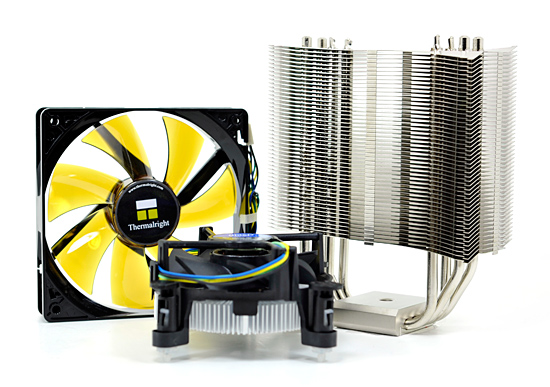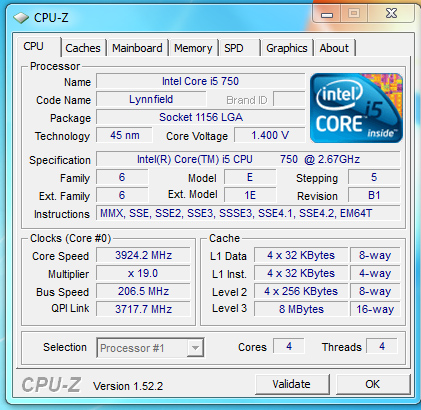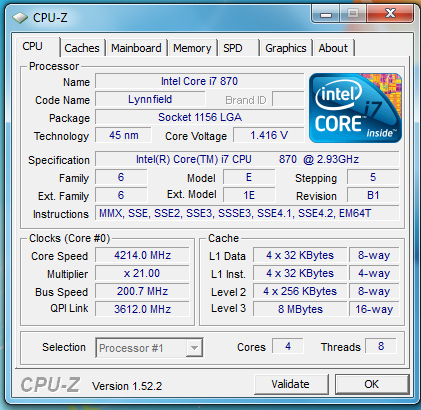Intel's Core i7 870 & i5 750, Lynnfield: Harder, Better, Faster Stronger
by Anand Lal Shimpi on September 8, 2009 12:00 AM EST- Posted in
- CPUs
Overclocking: Great When Overvolted, Otherwise...
Back when I asked Intel why anyone would opt for LGA-1366 over LGA-1156 one of the responses I got was: overclocking. The most overclockable CPUs will be LGA-1366 chips.
We tried overclocking three different CPUs: the Core i7 870, Core i7 860 and Core i5 750. We overclocked using two different coolers: the retail low profile HSF and a Thermalright MUX-120 (the heatsink Intel is sending around to reviewers for high performance testing). I'll get one thing out of the way: the retail heatsink pretty much sucks for overclocking:
| Intel Core i7 870 | Max Overclock (Turbo Disabled) |
| Intel Retail LGA-1156 Cooler | 3.52GHz (160MHz x 22.0) |
| Thermalright MUX-120 | 4.20GHz (200MHz x 21.0) |
The Thermalright enables higher overclocks by removing heat quickly enough allowing us to increase the voltage to the CPU. While roughly 1.35V is the limit for the retail cooler, The Thermalright MUX-120 let us go up to 1.40V. In both cases you need to have a well ventilated case.

Um, yeah.
Now for the actual overclocking results. We overclocked in two ways: 1) with turbo mode enabled and ensuring stability at all turbo frequencies (both single and multiple cores active), and 2) with turbo mode disabled simply going for highest clock speed.
The results are in the table below:
| CPU | Stock Clock Speed | Max Overclock (Turbo Enabled) | Max Overclock (Turbo Disabled) |
| Intel Core i7 870 | 2.93GHz | Default: 3.39GHz (154 x 22.0) 3C/4C Active: 3.70GHz | 4.20GHz (200 x 21.0) |
| Intel Core i7 860 | 2.80GHz | 3.23GHz (154 x 21.0) 3C/4C Active: 3.54GHz | 3.99GHz (210 x 19.0) |
| Intel Core i5 750 | 2.66GHz | 3.2GHz (160 x 20.0) 3C/4C Active: 3.96GHz | 3.92GHz (206.5 x 19) |
For best performance with all four cores active, disabling turbo mode is the way to go. Otherwise you have to reduce the BCLK in order to make sure your system is still stable when the one-active-core turbo mode kicks in. For example, with our Core i7 870 with turbo disabled we hit 4.2GHz using a 200MHz BCLK. If we used the same BCLK but left turbo enabled, when only one core was active we'd hit 5.4GHz - clearly not realistic with only air cooling.
The benefit of leaving turbo enabled is that you get a more balanced system that's not always using more power than it needs to.

The Core i5 750

Our Core i7 860 sample wasn't that great of an overclocker

Breaking 4.2GHz with our Core i7 870
At roughly 4GHz overclocks for all of these CPUs, it's reasonable to say that they are good overclockers. But how about with no additional voltage and the retail heatsink?
| CPU | Stock Clock Speed | Max Overclock, Turbo Disabled (No Additional Voltage) |
| Intel Core i7 870 | 2.93GHz | 3.37GHz (22 x 153MHz) |
The stock overclocks just plain suck on Lynnfield, you need added voltage to overclock the chip. With more voltage it works just like a Bloomfield or Phenom II, but at stock voltages Lynnfield just doesn't clock very high. And it has nothing to do with yields.










343 Comments
View All Comments
Griswold - Tuesday, September 8, 2009 - link
You definitely ARE stupid.dragunover - Tuesday, September 8, 2009 - link
Readers aren't, but you didn't read...snakeoil - Tuesday, September 8, 2009 - link
wow, this lynnfield is expensive, and the motherboards are expensive too.this is a crippled core i7 and you will have problems because the northbrige only have 2 x 8 pcie express electrical.
so if you are going to buy a new directx 11 video card don't commit the mistake of buying a lynnfield which is crippled.
without hyperthreading in some cases is a 40% slower than core i7
Eeqmcsq - Tuesday, September 8, 2009 - link
Anand, can't you just ban this guy? He's always trolls against Intel here, TechReport, and a couple other tech sites.JonnyDough - Tuesday, September 8, 2009 - link
I second the notion.Chlorus - Tuesday, September 8, 2009 - link
Thirded.maddoctor - Tuesday, September 8, 2009 - link
Your comment will not affect people whose committed to bought these. I think it is more valuable than any AMD platform. I don't think AMD will survive next year.TA152H - Tuesday, September 8, 2009 - link
From a purely processor perspective, I'd agree, but AMD platforms are pretty strong when you compare IGPs. The G45 compared to the 790GX is worse comparison than the Phenom II compared to the Nehalem.Don't forget IGPs are a HUGE market, so it's not an unimportant consideration.
PassingBy - Tuesday, September 8, 2009 - link
Yes, the IGP market is huge and Intel dominates that market as it is. If Intel can get its drivers right, then it looks like the IGP on Clarkdale/Arrandale will extend that domination. If you want to game seriously on graphics intensive games, then don't use an IGP.ash9 - Tuesday, September 8, 2009 - link
broaden your horizons; the real money is in corporate retooling- that said AMD's platform is without question offer more bang for the buck, considering corporate needs...most corporate folk have gone blind because of Intel's IPG's (laptops and desktops)Anand how bout running the tests that addresses that issue (IPG's and eye strain)